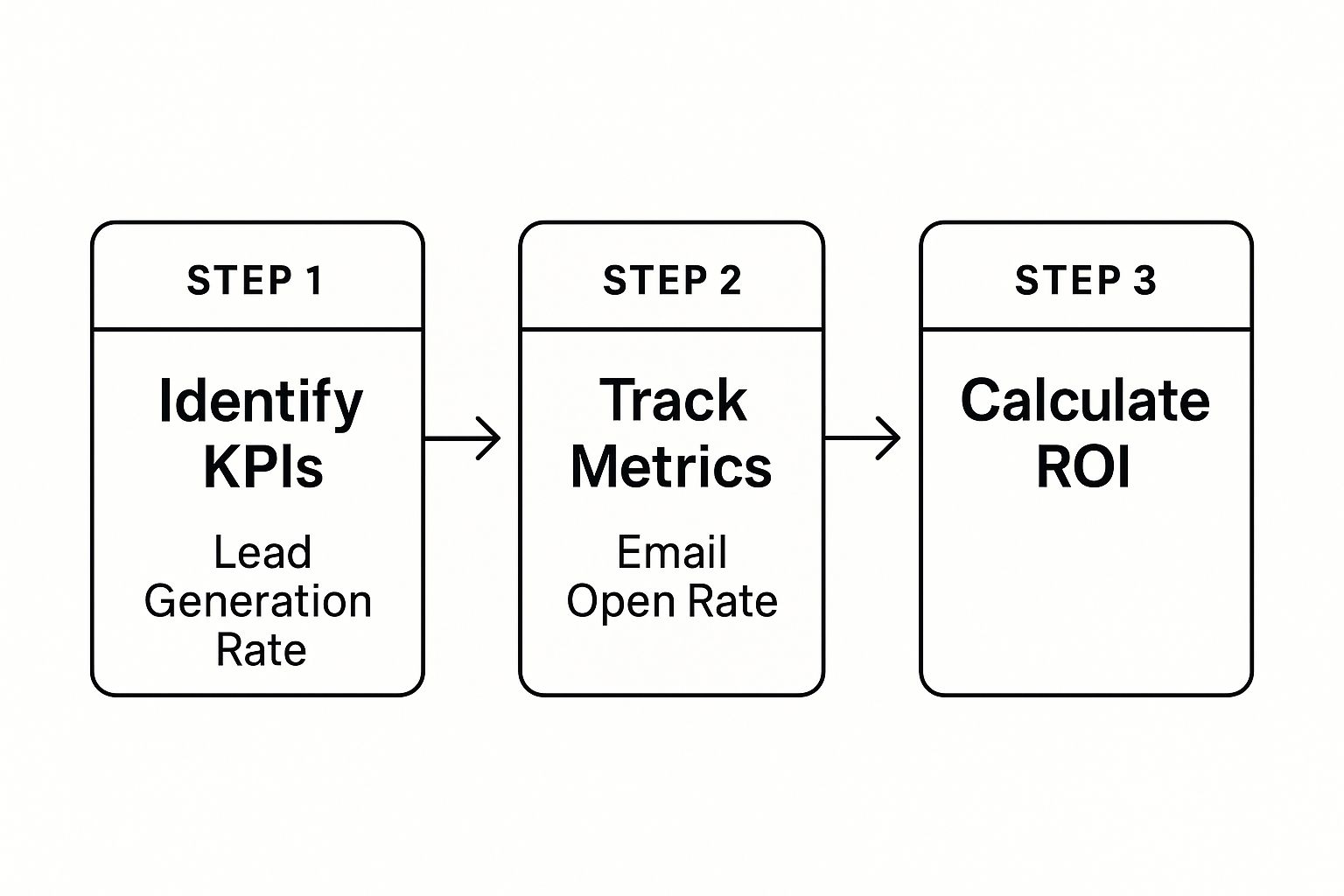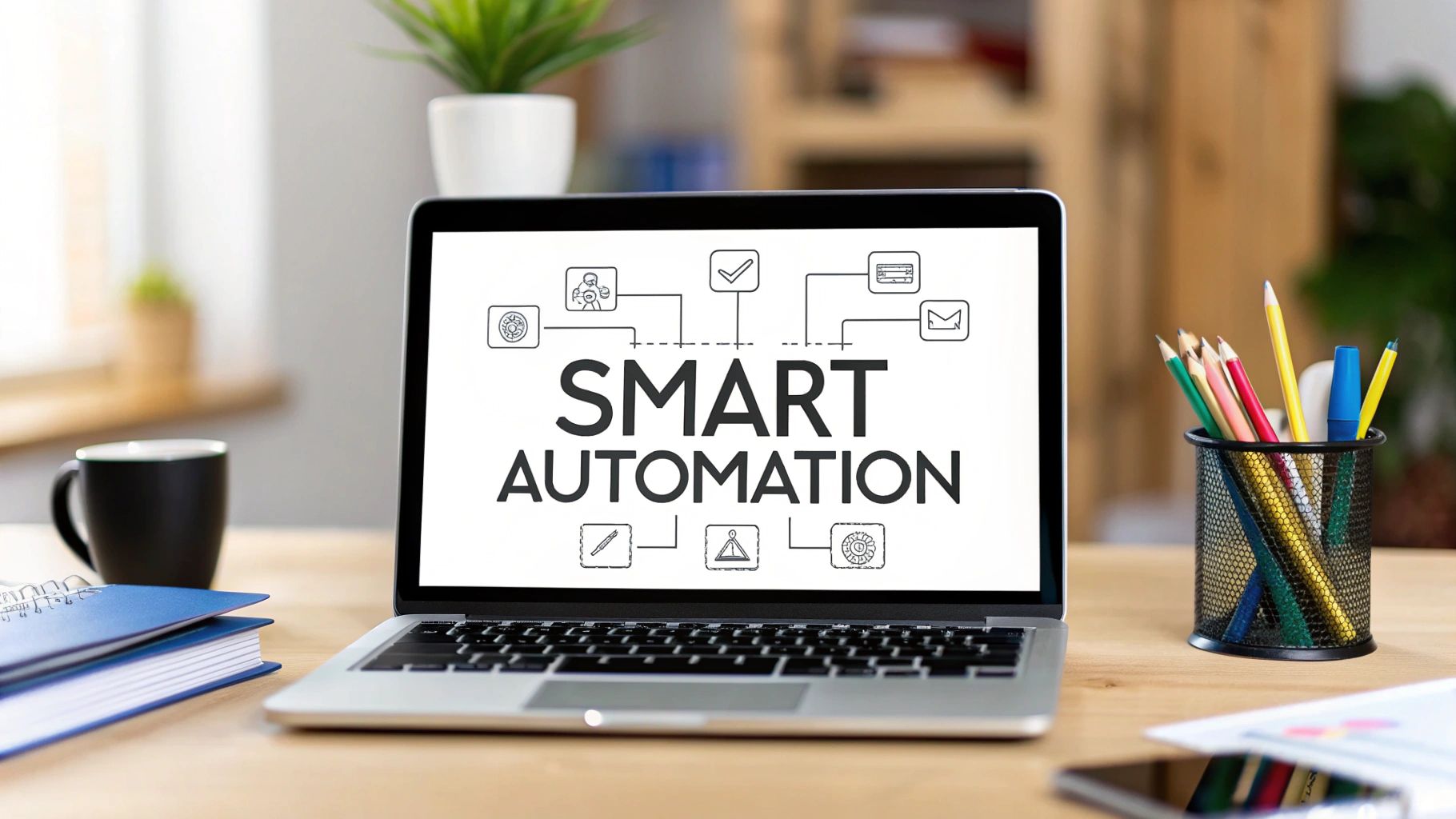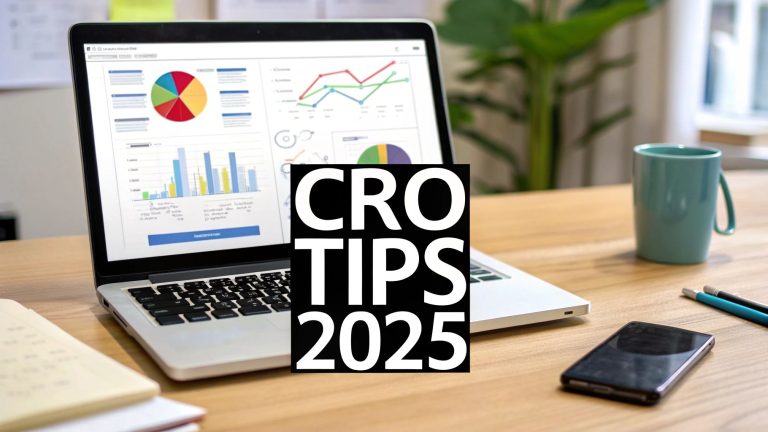Marketing Automation for Small Business: Boost Growth Fast
Understanding Marketing Automation: Beyond the Buzzwords
Picture this: you own a small bakery. Instead of personally greeting every customer, taking orders, and handing out loyalty cards, you have a helpful system in place. New subscribers to your newsletter get a warm welcome email. Customers receive birthday greetings with special offers. And when their favorite sourdough is fresh out of the oven, they get a friendly reminder. That, my friend, is marketing automation for your small business. It's not about replacing the human touch, it's about making it even more powerful.
This move towards automation isn't just a passing fad; it's quickly becoming vital for small businesses to thrive. More and more businesses are realizing the benefits. By 2024, 58% of marketing decision-makers automated their email campaigns, 49% automated social media, and 33% automated their content management. This shows just how much value businesses are finding in streamlining their operations and connecting with their customers more effectively. For a deeper dive into these trends, check out this article on automation adoption: Automation Statistics.
Marketing automation helps you build strong relationships with lots of customers, nurturing each lead as if they were your only one. Think of it like having an extra set of hands handling the repetitive tasks, freeing you up to focus on what you do best – like baking that perfect loaf of bread or creating your next delicious treat. This personal touch, something small businesses are known for, becomes even stronger with automation, giving you a real leg up on the competition.
How Does Marketing Automation Work?
The image below shows the core parts of a typical marketing automation system:
The cycle starts with attracting visitors, then converting them into leads. From there, it's all about nurturing those leads and finally, turning them into paying customers. This continuous cycle ensures you're always engaging with your audience and improving your approach, which ultimately helps your business grow.
Understanding this cycle helps you see the difference between basic scheduling tools (like posting to social media on a timer) and true marketing automation platforms like LeadSavvy Pro. LeadSavvy Pro creates personalized experiences for each customer based on their actions and preferences. This is a key difference for small businesses looking to get the most out of their automation investment. It’s the difference between sending generic messages and having real, meaningful conversations.
The Small Business Advantage: Why Automation Levels the Playing Field

Marketing automation isn't just a trendy add-on for small businesses; it's a fundamental shift in how you compete. Think of it like this: big corporations may have massive resources, but they often get bogged down in internal processes. Small businesses, on the other hand, are inherently nimble. They can adjust their strategies on a dime. This adaptability, combined with the power of automation, creates a serious competitive edge.
Let's say you're a small consulting firm with a team of three. Trying to personally follow up with every single lead is a drain on your time and limits how much you can grow. But with marketing automation, you can set up a system that nurtures those leads based on their specific interests and what they do on your website. Suddenly, you're playing in the same league as firms ten times your size. That’s the beauty of using technology to even the odds.
Building Trust and Loyalty Through Consistent Communication
Staying in touch regularly with relevant messages is crucial for building strong customer relationships. Marketing automation empowers small businesses to send personalized messages at a large scale, which deepens those connections. This consistent engagement resonates with people; it makes them feel valued and understood. You can't just buy that kind of authentic connection with advertising; it's built through thoughtful, personalized interactions.
Small businesses also have a unique advantage when it comes to adding that personal touch. They can quickly tailor their messaging to really connect with their audience, creating a sense of community. This is where large corporations often miss the mark; their size can make them feel impersonal and distant.
The financial benefits of marketing automation for small businesses are real. Companies that invest in this technology typically see a great return. In fact, for every dollar spent on marketing automation, businesses earn $5.44. That’s a powerful impact on your bottom line. Want to learn more about the financial benefits? Check this out: Learn more about marketing automation ROI.
Agility and Customer-Focused Decisions
Small businesses are in a fantastic position to make quick, customer-centric decisions. Without layers of corporate red tape, they can make changes and react to customer feedback instantly. This agility is a major asset in today’s market. Combined with the power of marketing automation, small businesses can achieve incredible results, often outperforming larger competitors. It's a powerful combination that fuels growth and builds long-lasting customer relationships.
To illustrate the key differences, let's take a look at the following comparison:
Small Business vs Enterprise: Marketing Automation Benefits Comparison
This table highlights how marketing automation benefits differ for small businesses and large enterprises, emphasizing the unique advantages for smaller companies.
| Benefit Category | Small Business Impact | Enterprise Impact | Small Business Advantage |
|---|---|---|---|
| Agility & Implementation | Quick setup and adjustments, minimal red tape | Longer implementation cycles, complex approvals | Faster time to value, adaptable to market changes |
| Personalization | Highly targeted messaging, direct customer interaction | Broader audience reach, potential for impersonal feel | Stronger customer connections, increased engagement |
| Cost-Effectiveness | Significant ROI on smaller budgets, reduced overhead | High initial investment, potential for complex integrations | Greater affordability, quicker return on investment |
| Customer Focus | Rapid response to feedback, flexible campaign adjustments | Slower response time, bureaucratic hurdles to change | Enhanced customer experience, stronger loyalty |
As you can see, while enterprises benefit from scale, small businesses gain a powerful edge in speed, personalization, and customer focus when using marketing automation. This allows them to compete effectively and build thriving businesses.
Essential Features That Actually Move the Needle
Picking the right marketing automation tools can be a bit like navigating a crowded marketplace. So many options, so many promises! How do you know which features truly matter for a small business? We've analyzed what works for businesses just like yours, and we've boiled it down to the core capabilities that deliver real results. Forget the bells and whistles – this is about smart investments that boost your bottom line.
Email Automation: Beyond Basic Newsletters
Imagine having a tireless assistant who sends perfectly timed, personalized emails to every lead. That’s the power of email automation. It’s much more than just sending out newsletters. Think of it as creating smart email sequences that respond to your customer’s actions and guide them through your sales process.
For example, let’s say a potential customer downloads a free guide from your website. Your automation platform sends a thank you email with additional helpful resources, then continues to nurture that lead with valuable content based on their interests. This targeted approach builds trust and keeps your business top-of-mind. You might be interested in: automated lead nurturing.
Lead Scoring: Identifying Your Hottest Prospects
Ever wish you had a crystal ball to tell you which leads are ready to buy? Lead scoring is the next best thing. It’s like assigning points to each customer based on their actions. Website visits, email opens, content downloads – all of these contribute to a lead’s score. This helps you prioritize your efforts, focusing on the hottest prospects while continuing to nurture those who need more information.
This way, you avoid wasting time on cold leads and ensure your sales team focuses on the most promising opportunities.
CRM Integration: A Single Source of Truth
Juggling customer data across different platforms is a recipe for disaster. CRM integration brings all your customer information into one central hub. It's like having a command center where you can see every interaction, every detail, all in one place. This eliminates data chaos and allows you to personalize every communication, building stronger relationships and boosting your conversion rates.
Workflow Builders: Automation for Real People
Many automation platforms offer complex workflow builders that feel like they were designed for programmers, not business owners. Look for a platform with a visual workflow builder. Think drag-and-drop simplicity. These tools empower you to create automated sequences without needing coding skills, saving you time and frustration so you can quickly adapt to changing customer needs.
Reporting Dashboards: Measuring What Matters
Data is powerful, but only if you can understand it. Choose a platform with reporting dashboards that focus on the metrics that truly matter for your business, like conversion rates, lead generation, and customer lifetime value. Clear, concise reports help you understand what's working, identify areas for improvement, and make informed decisions that fuel growth.
To help you prioritize which features to implement first, we've created a handy table:
Marketing Automation Features: Priority Matrix for Small Businesses
A comprehensive breakdown of marketing automation features ranked by importance and impact for small businesses, with implementation difficulty ratings
| Feature | Business Impact | Implementation Difficulty | Priority Level | Recommended For |
|---|---|---|---|---|
| Email Automation | High | Low | High | All Businesses |
| Lead Scoring | Medium | Medium | Medium | Businesses with established sales processes |
| CRM Integration | High | Medium | High | All Businesses |
| Workflow Builders | High | Low | High | All Businesses |
| Reporting Dashboards | High | Low | High | All Businesses |
This table highlights the importance of features like email automation, CRM integration, workflow builders, and reporting dashboards as foundational elements for small business marketing automation. While lead scoring is valuable, it's often best implemented after establishing core processes. By focusing on these key areas, you can build a powerful automation system that drives real growth.
Real Success Stories: How Small Businesses Win With Automation
Real-world examples are the best way to understand the power of marketing automation for small businesses. Let's explore some inspiring stories of how small businesses transformed their operations and saw amazing results through smart automation.
From Struggling to Thriving: A Restaurant's Automation Journey
Picture a family-owned restaurant struggling to get customers to come back a second time. They implemented a simple automated birthday campaign using a platform like LeadSavvy Pro, sending personalized greetings with a special offer. They also automated their loyalty program, rewarding repeat customers with exclusive deals.
Within six months, return visits increased by 40%. Their secret? They focused on making each automated message feel personal and valuable, not just another advertisement. This personal touch truly connected with their customers.
Cutting the Sales Cycle in Half: A Consulting Firm's Success
For a small consulting firm, manually following up with every lead takes a lot of time. By setting up a lead nurturing sequence, one firm automated sending the right information at the right time.
This automated system built trust with potential clients before the first sales call, cutting their sales cycle in half. This shows how marketing automation frees up valuable time for small business owners and their teams. Now they can focus on other crucial tasks.
Recovering Lost Sales: An E-commerce Store's Automation Strategy
Abandoned shopping carts are a common problem for online stores. One e-commerce business realized they were losing 25% of potential sales this way. They implemented an automated cart recovery campaign, sending well-timed reminders that addressed common customer concerns and offered helpful incentives.
This simple automation recovered 25% of those lost sales, demonstrating how automation can address specific pain points and directly improve profits.

The screenshot above shows LeadSavvy Pro's easy-to-use interface for managing Facebook Lead Ads. Even non-technical users can easily automate lead capture and follow-up. The clear layout and simple controls suggest LeadSavvy Pro prioritizes user-friendliness and efficient workflow management. These features are essential for small businesses seeking simple automation solutions.
Learning From Success: Key Takeaways
These success stories show the potential of marketing automation for small businesses. They highlight several key lessons:
-
Personalization is Paramount: Even automated messages should feel custom-made and relevant to each customer.
-
Timing is Key: Delivering the right message at the right time can significantly impact customer engagement and conversion rates.
-
Automation Doesn't Replace the Human Touch: It enhances it by freeing up time for more meaningful interactions with customers.
-
Measurable Results: Automation lets small businesses track progress, analyze data, and refine strategies for constant improvement.
These examples show how even simple automation strategies can bring big results. Marketing automation isn't just for large corporations. It's a powerful tool for any small business looking to grow and succeed. By learning from these real-world examples, you can gain valuable insights and inspiration for your own automation strategies. These businesses prove that with the right approach, marketing automation can be a game-changer.
Choosing Your Perfect Automation Partner: A Practical Framework

Picking the right marketing automation platform for your small business can feel like navigating a maze. So many options, so many promises! This section gives you a practical framework, based on real-world experience, to help you find the perfect fit. It's not about ticking off features on a list, it’s about finding a partner that truly understands your needs.
Beyond the Basics: Evaluating Your Options
Sure, features are important, but other factors play a huge role in your long-term success with marketing automation. Think about the learning curve. Will your team be able to use the platform easily, or will it require a PhD in rocket science? Customer support is crucial, especially when you're just starting out. And don't forget about scalability – you want a platform that can grow alongside your business. These often-overlooked aspects can be the difference between smooth sailing and a rocky road.
For instance, imagine a platform so complex it needs weeks of training. That eats up valuable time and resources. A user-friendly platform like LeadSavvy Pro lets your team hit the ground running, maximizing your investment.
Asking the Right Questions During Vendor Demos
Vendor demos are your chance to kick the tires and see the platform in action. Don't just passively listen to the sales pitch. Ask pointed questions that reveal how well the platform handles the unique challenges small businesses face. How does it handle data migration from your existing systems? What integrations does it offer with the tools you already use? These practical questions give you valuable insights.
Also, dig into the pricing. What's the true cost of ownership? Consider hidden fees, training costs, and integration expenses. This big-picture approach helps you make a smart financial decision. Need some tips on automating lead generation? Check out our guide: how to automate lead generation.
Red Flags and Green Flags: Identifying the Right Fit
As you evaluate different platforms, watch out for red flags that suggest a platform might be too complex or designed for larger enterprises. Overly complicated features, hefty setup costs, and a lack of small business-focused support are all potential warning signs.
Look for green flags too – signs that a platform gets the small business world. A user-friendly interface, reasonable pricing, excellent customer support, and a focus on practical applications are all good indicators. These are the hallmarks of a potential partner, not just a vendor.
Practical Checklists and Scoring Methods for Objective Decisions
Want to make a clear-headed decision? Create a checklist of must-have features and criteria. Rank each item based on its importance to your business. Then, during vendor demos, score each platform against your checklist. This structured approach helps you compare apples to apples and choose the platform that best aligns with your business goals.
This practical framework helps you cut through the marketing hype and select the perfect automation partner. It empowers you to make a strategic choice that fuels growth and maximizes your return on investment. By considering these factors, you'll choose a platform that supports your needs today and your aspirations for tomorrow.
Your Implementation Roadmap: From Setup to Success
Ready to see what marketing automation can do for your business? This roadmap breaks down the implementation process into easy-to-manage phases, setting your small business up for success with marketing automation. We’ll walk you through everything, from pre-launch prep to a fully integrated system.
Phase 1: Pre-Launch – Laying the Foundation
Think of this phase as getting all your ducks in a row. Before automating anything, you need a solid base. This pre-launch phase has three key parts:
-
Process Audit: Look at your current marketing efforts. Where are the bottlenecks? What tasks do you repeat over and over? Where can automation help? It’s like spring cleaning for your marketing – clearing out the clutter for a better system.
-
Data Organization: Clean and organize your contact data. Accurate, segmented lists are essential for personalized automation. This ensures your messages reach the right people at the right time.
-
Workflow Design: Map out your core automated workflows. Start with the basics like welcome emails, lead nurturing, and abandoned cart reminders. Planning this out early will prevent issues later.
Phase 2: First 30 Days – Launching and Learning
The first month is all about getting those initial automated campaigns live.
-
Initial Campaign Launch: Get your core workflows running. Start with a small batch of campaigns to test and refine your approach. It’s better to start small and gain momentum than to do everything at once and feel overwhelmed.
-
Tracking Setup: Set up the right tracking tools. Watch important metrics like open rates, click-through rates, and conversions. This data tells you what’s working and where you can improve.
-
Monitoring Routine: Check your dashboards and reports regularly (daily or weekly) to see what’s happening and adjust as needed. This routine helps you stay on top of your automation performance.
The infographic below shows how to measure your marketing automation ROI. It starts with figuring out your key performance indicators (KPIs), then tracking metrics, and finally calculating your return on investment.

These three simple steps highlight how important a data-driven approach is to marketing automation. By looking at these metrics, small businesses can learn how their campaigns are performing and fine-tune their strategies for the best ROI.
Phase 3: 60 Days – Optimizing and Expanding
After the first month, turn your attention to improving and strategically growing your automation.
-
Performance Analysis: Dive into your campaign data. Where can you make improvements? Adjust your workflows and messaging accordingly. Data is key to maximizing your return.
-
Workflow Expansion: Add new automated workflows based on what you’ve learned. Consider things like lead scoring, automating your social media, or more complex email sequences.
-
A/B Testing: Run A/B tests to further refine your campaigns. Try different subject lines, email content, and calls to action. This helps you figure out what works best for your audience.
Phase 4: 90 Days – Full Integration
By now, your marketing automation should be a regular part of your business.
-
System Integration: Connect your automation platform with your other tools like your CRM and e-commerce platform. This keeps data flowing smoothly between departments.
-
Team Training: Make sure your team knows how to use these tools and understand the data they’re seeing. A well-trained team makes the most of automation.
-
Continuous Improvement: Regularly review how your automation is doing, get feedback from your team, and make changes as needed. Marketing automation is an ongoing process. This roadmap will help you improve your marketing, work more efficiently, and unlock the real potential of marketing automation for your small business. Remember, it's a marathon, not a sprint!
Measuring What Matters and Scaling Your Success
Implementing marketing automation is just the first step. The real boost for small businesses comes from optimizing and strategically scaling your efforts. Forget superficial metrics like social media likes. We're talking about measurements that truly impact your bottom line: conversion rates, customer lifetime value, and return on investment (ROI).
Building Actionable Dashboards
Think of your dashboard as your marketing control center, giving you a quick overview of what's working and what needs tweaking. Instead of a jumble of numbers, you need a clear view of the key metrics. For example, tracking your cost per acquisition (CPA) helps you see which campaigns are most effective at attracting new customers. This data-driven approach empowers you to make smart decisions about where to invest your marketing budget.
A/B Testing for Small Businesses
A/B testing is like a friendly competition between two versions of your marketing materials. Test different subject lines, calls to action, or even landing pages to see which performs better. Even with a smaller audience than larger companies, you can still gain valuable insights. For instance, testing two different email subject lines might reveal one has a much better open rate. You might be interested in: Check out our guide on CRM and lead generation.
Scaling Your Automation: Maintaining the Personal Touch
As your business grows, so should your automation. This means handling larger volumes while still keeping that personal touch. Advanced segmentation lets you divide your audience into smaller, more targeted groups based on their behavior and preferences. It's like tailoring your message to speak directly to each individual, even as your customer base expands, keeping your communication relevant and engaging.
Multi-Channel Coordination and System Integration
Imagine your customers having a seamless experience across all your marketing platforms. Multi-channel campaign coordination makes that possible. Integrating your email marketing, social media, and other channels creates a unified, personalized experience. Further, connecting your marketing automation platform with other systems like your CRM improves efficiency. This allows for smooth data flow and removes data silos, ensuring everyone in your company has the latest customer information.
Identifying New Automation Opportunities and Navigating Scaling Challenges
Effective scaling means always looking for new automation opportunities. Analyze customer behavior and your business processes to find areas where automation can improve operations and customer experience. But scaling also has its challenges. Maintaining a personal touch as you grow, managing larger amounts of data, and adapting to market changes are all hurdles to address. By learning from businesses that have successfully scaled their automation, you can avoid common mistakes. For example, some companies use automation to personalize onboarding, welcoming new customers with tailored messages and helpful resources.
Ready to unlock the true power of marketing automation for your small business? LeadSavvy Pro simplifies lead capture and management, so you can focus on what matters most – growing your business. Start your free trial today and see the difference: https://leadsavvy.pro







